Pan De Yema: 5 Secrets Of Oaxaca Day of the Dead Bread
Disclosure: This post may contain affiliate links, meaning that I may get a small commission if you decide to make a purchase through my links, at no cost to you.
Have you heard about the Oaxacan bread known as pan de yema and wondered what it is?
Pan de yema, also known as pan de muerto or Day of the Dead bread, is a traditional Oaxacan bread best known for its use in Oaxaca’s Day of the Dead festival.
It is a sweet bread made from a dough heavy with eggs and egg yolks (yema in Spanish), which give it a flaky texture and a distinctive golden hue.
Although this fascinating type of bread is found throughout Mexico, it has a special mystique in Oaxaca. I’ve revealed below five secrets about Oaxacan pan de yema that most people don’t know.
Read on to find out what they are!
PAN DE YEMA: OAXACA DAY OF THE DEAD BREAD
How Do You Pronounce Pan De Yema?

Before we get ahead of ourselves, let’s look quickly at how to pronounce pan de yema. You’ll need to know how to say it correctly if you want buy it in a bakery in Oaxaca!
The key to pronouncing it properly is in getting the sounds of the vowels right. Once you can do that, you’ll sound like a pro.
Let’s look at each of the three words in turn. The first two have just one syllable, and the last one has two syllables.
The first word is pan, which is pronounced like PAHN. The “a” sounds like the “a” in “father.”
The second word is de. That one is also a little drawn out and is pronounced like DAY.
The last one is yema. Here, there are two syllables and the accent is on the first syllable. Like the previous two words, the vowel sounds are long, and it is pronounced YEH – MAH.
Putting it all together, pan de yema is pronounced PAHN – DAY – YEH-MAH.
Simple, right?
Now that you know how to pronounce it, let’s just briefly touch on where Oaxaca is for those who haven’t yet visited it!
PAN DE YEMA: OAXACA DAY OF THE DEAD BREAD
Where is Oaxaca, Mexico?
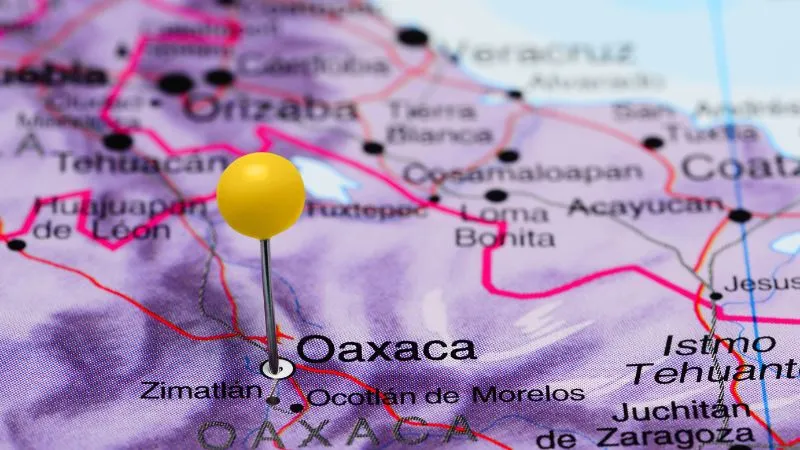
Oaxaca is a region of southern Mexico, bound to the south by the Pacific Ocean.
It neighbours the state of Chiapas to the east, the states of Puebla and Veracruz to the north, and the state of Guerrero to the west.
Oaxaca City is the capital city of Oaxaca state and its cultural center. It lies in the Oaxaca Valley surrounded by stunning mountains and beautiful landscapes.
The historic center of Oaxaca City is a UNESCO World Heritage Site and is adorned with beautiful cobblestoned streets, breathtaking colonial architecture, and colorful markets.
It’s a rare gem, even for the beautiful land that is Mexico, and in my opinion it really is a must-visit destination.
PAN DE YEMA: OAXACA DAY OF THE DEAD BREAD
Why Should You Visit Oaxaca?
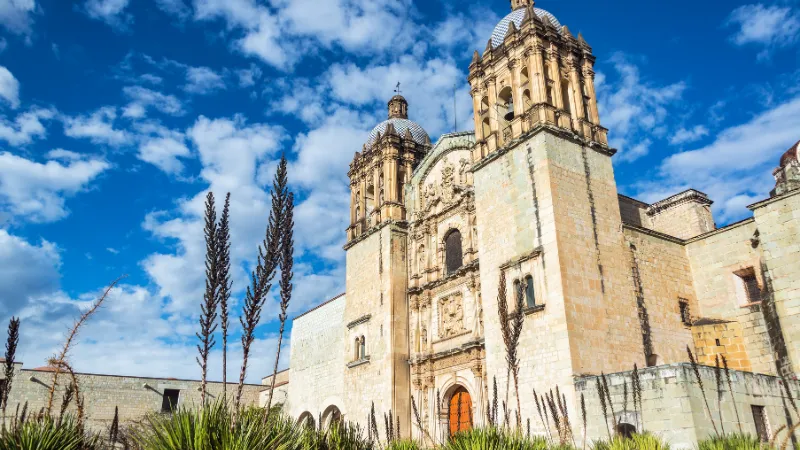
Oaxaca is worth visiting for many reasons!
It has a rich cultural heritage, beautiful colors everywhere, and wonderfully friendly people.
There are real wonders of the world like Hierve el Agua and the Tule Tree are just a short drive away from Oaxaca de Juárez.
It has beautiful buildings that are centuries old and breathtaking ruins that are thousands of years old.
Each year it holds flamboyant traditional festivals such as Day of the Dead, La Guelaguetza, and Noche de Rábanos.
And there are brilliant artisans of all kinds selling their goods in wonderful markets. One of these unique goods is pan de yema!
So let me try to persuade you to visit Oaxaca by revealing five of the secrets of pan de yema, Oaxaca’s intriguing form of bread.
PAN DE YEMA: OAXACA DAY OF THE DEAD BREAD
5 Secrets of Oaxaca Day Of The Dead Bread
Ready to hear some amazing things about Oaxacan pan de yema? I’ve set out below five little-known secrets of Oaxaca’s Day of the Dead bread.
1: Oaxaca Bread Is Amazing With Chocolate
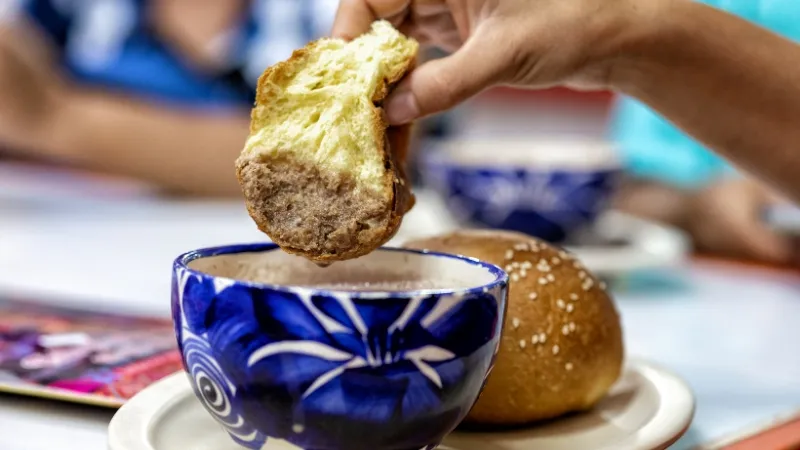
Most people associate Oaxaca bread with the Day of the Dead festival in Oaxaca.
That’s obviously correct, as pan de yema plays a very important part in the traditions followed by local Oaxacans during the Day of the Dead festival.
But what many people don’t know is that pan de yema is eaten all year round, most commonly as a breakfast dunking bread enjoyed with a Oaxacan hot chocolate.
Much like the French who tear apart their croissants and soak them in their morning coffee, local Oaxacans can be found in a cafe tearing up their pan de yema rolls and dipping them in their morning hot chocolate.
Although pan de yema is oven-baked and has a crispy outside, the soft flesh of the roll is flaky and absorbent. Its tender and sweet texture is absolutely perfect for dipping in a cup of hot chocolate.
So if you’re in Oaxaca and you want to feel like a local, this is a cheap and very easy way to do it.
All you have to do is pop into a local cafe in the cool of the morning and order a breakfast of pan de yema and hot chocolate, and you can experience firsthand one of Oaxaca’s key local rituals.
PAN DE YEMA: OAXACA DAY OF THE DEAD BREAD
2: Caritas Are More Than Just A Pretty Face
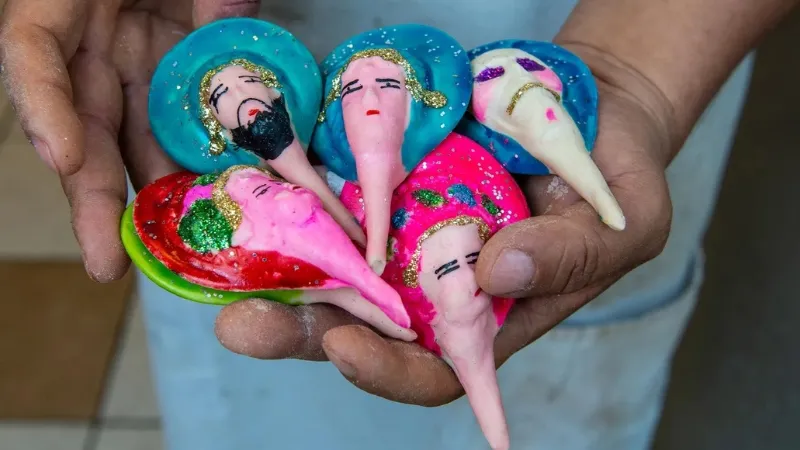
You have probably seen that the pan de yema baked during the Oaxaca Day of the Dead festival has tiny little figures baked onto the outside of the bread.
When you look closely you might have noticed that they are actually cute hand-painted little faces.
What you probably didn’t know is that these tiny faces are what turn pan de yema into pan de muerto, also known as Oaxacan Day of the Dead bread.
This is because in the Oaxacan Day of the Dead tradition, caritas represent the faces of the dead with the bread symbolising the body of the departed.
They serve as a representation of departed souls and a way to honor and remember loved ones who have passed away.
Because they are hand-painted, each carita is unique, reflecting the personality and characteristics of the person being remembered.
During the Day of the Dead in Oaxaca you will often see ofrendas (altars) on the gravesites of departed loved ones, with pan de yema having pride of place.
The beautifully made caritas sit atop the crispy bread and stare back at the families gathered around the gravestone, helping to form an important link between the living and the dead.
PAN DE YEMA: OAXACA DAY OF THE DEAD BREAD
3: There Are More Than 400 Types Of Pan De Yema

If you think that there can’t really be that much variety in Oaxacan bread, well, in this case you would be wrong.
Across Mexico during the Day of the Dead celebrations, there are thought to be over 400 types of pan de muerto baked in ovens during that three-day period.
In Oaxaca alone, there are said to be dozens of different types of pan de muerto.
The earliest version of pan de yema is generally accepted to have been created in Santo Domingo Tomaltepec, about eight miles to the east of Oaxaca City. However, not wanting to be outdone, most Oaxacan towns have added their own unique twist to the original creation.
The town of San Pedro Tidaá is known for baking its pan de muerto with pulque, a fermented agave drink. The pulque gives the bread a distinct slightly fermented flavour that sets it apart from the more classical variety of pan de yema.
Day of the Dead bread from Villa Sola de Vega in the Sierra Sur region of Oaxaca bakes its pan de muerto with doughy arms and legs. Once the carita is attached at the top, the creation takes a more lifelike effect that the traditional pan de muerto that is more commonly available.
In almost every town near Oaxaca City, the pan de yema that you buy in a local bakery will have a subtle twist on the original creation, as the local artisans put their creative stamp on their products.
So even though most of the pan de muerto that you will try in Oaxaca City will be pan de yema, if you travel just a short distance outside the city limits you’ll be able to find an astonishing variety of different creations.
PAN DE YEMA: OAXACA DAY OF THE DEAD BREAD
4: Cinnamon And Aniseed, Beacons For The Dead
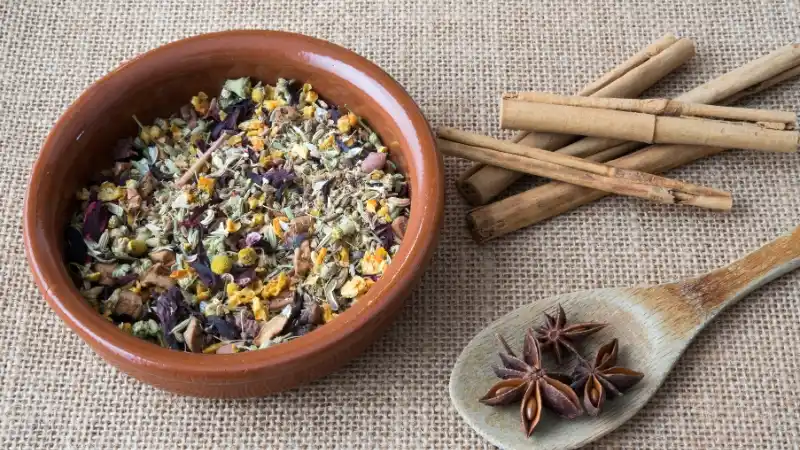
You may have tried pan de yema during the Oaxaca Day of the Dead festival and have noted the peculiar contrast of the sweet cinnamon notes with the strong licorice undertone.
Those ingredients are commonly used when baking pan de muerto during the Día de los Muertos celebrations.
However, what you may not know is that those flavours are only a feature of pan de yema during that brief three-day period.
Before it begins and after it ends, the cinnamon and anise aren’t included in the recipe. So why are they included during the Day of the Dead festival?
The reason is that the strong aromas of the cinnamon and aniseed are believed to serve as a beacon or lighthouse for those who have crossed over. They help guide the dead back to the world of the living for the short time of the festival.
This is one of the reasons that pan de muerto is laid out on ofrendas by the families gathering around the graves of their deceased loved ones.
It is a key part of the process of reaching out across the void to temporarily join the land of the living with the land of the dead.
So the next time to you see the cute bread rolls on the gravesites, you’ll know that they do more than just decorate the ofrenda. They are an important traditional beacon to bring loved ones home to their families for a brief but important moment in time.
PAN DE YEMA: OAXACA DAY OF THE DEAD BREAD
5. Literally A Lifesaver

You are probably aware that Oaxacan culture is extremely diverse.
Its diversity comes from a colorful mixture of pre-Hispanic Mixtec and Aztec culture overlaid by the influence of the Spanish after their arrival in 1519.
What you may not know is that an early form of pan de muerto may literally have saved many lives.
The Aztec civilization was known for performing various forms of human sacrifice. One of these was the practice of cutting out the heart of a virgin woman and offering it to the gods.
On arriving in Mexico, the Spanish colonists were appalled at the practice of human sacrifice and found this form of it particularly ghastly. They desperately wanted to to persuade the Aztecs leaders to abandon the practice in order to prevent the loss of life.
The Spanish colonists came up with a simple but very clever solution. Using locally made bread rolls, they coated them in a blood-red sugary icing intended to symbolise a real bleeding heart. They then set about persuading the Aztec leaders to substitute the colorful bread for a live heart.
Eventually, the newcomers were able to persuade the Aztecs to agree, and the widespread practice of this particular form of human sacrifice began to come to an end.
As a result, this early form of pan de muerto was likely responsible for saving many lives. Today, modern pan de muerto continues to enrich the lives of families by helping them to connect with the dead.
As is often said in Oaxaca, no one is really dead if someone living continues to remember them.
PAN DE YEMA: OAXACA DAY OF THE DEAD BREAD
What is the Oaxaca Day of the Dead Festival?
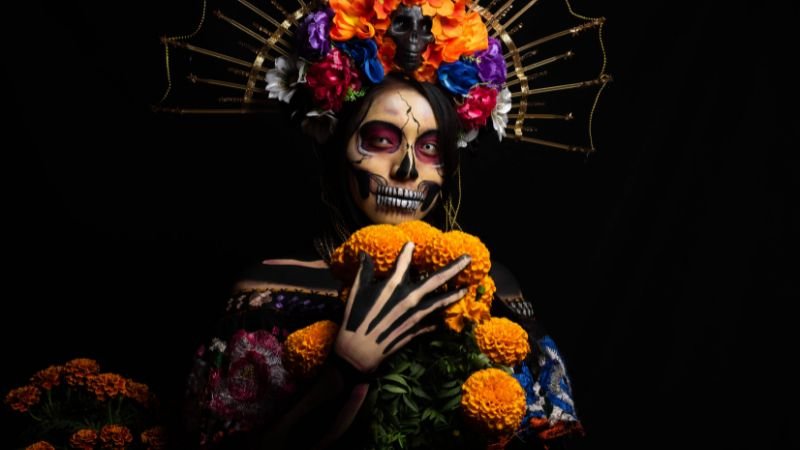
For those of you who haven’t experienced it, the Day of the Dead festival (Día de los Muertos) in Oaxaca is a captivating and colorful cultural celebration that pays homage to deceased loved ones.
Its a unique blend of indigenous traditions and Catholic influences, creating a colorful yet deeply meaningful commemoration.
Perhaps oddly, rather than being a somber occasion, it’s actually a joyous celebration of life. Death is embraced as a natural part of the human experience.
Throughout the festival, Oaxaca’s streets and cemeteries come alive with color, music, and traditions.
Families gather at gravesites to clean, decorate, and share stories of their departed loved ones. Elaborate parades, known as comparsas, fill the streets with dancers, musicians, and participants dressed as joyful skeletons.
Oaxacan families believe that during this time, the spirits of their loved ones return to the earthly realm to enjoy the offerings and festivities prepared for them. The lines between the living and the deceased blur, creating a sense of connection and continuity between life and death.
It’s a celebration that beautifully encapsulates Oaxaca’s rich cultural heritage, blending spirituality, artistry, and a profound reverence for life and death.
PAN DE YEMA: OAXACA DAY OF THE DEAD BREAD
How Is Pan De Muerto Used In Day Of The Dead?

As described above, Oaxaca’s intriguing bread is not like any old tasty baked good. It is loaded with tradition and plays several important roles during the Día de los Muertos festival.
In fact, according to Statista, 92% of people surveyed said that they planned to eat pan de muerto during the 2022 Day of the Dead celebrations.
I’ve set out below a few ways in which pan de muerto is important to Oaxaca’s iconic Day of the Dead festival.
Representation of Departed Loved Ones
One important role is its symbolic representation of a family’s departed loved ones.
Families hand-paint caritas representing the faces of family members or of their patron saints and bake them onto the bread itself.
The bread is then set upon ofrendas (altars) on cemetery gravestones or within the family home to create a direct link to the deceased family member.
A North Star For The Dead
Another role played by pan de muerto is as a guide for the dead to find their way back to the land of the living.
It is common to see pan de muerto sitting alongside marigold flowers, candles, and photographs of the departed on a family ofrenda. These items are used to create a beacon for the dead to follow on their voyage across the void.
How does the bread do this?
Bakers making pan de muerto include ingredients with recognisable flavours and strong scents. Common ingredients are cinnamon and anise, but others such as pulque are also used.
Final Communion
The last important role fulfilled by pan de muerto during the Day of the Dead festival is nourishing the bodies and souls of the family members gathered to meet their loved ones.
On the morning of November 2nd, families gather to literally break bread. The meal is often paired with hot chocolate or atole in a moment of communion with their ancestors.
Local Oaxacans spiritually connect with their loved ones in the ritual of eating and sharing food with the family and their ancestors. It’s a moment spent remembering the dead while also celebrating the living family.
PAN DE YEMA: OAXACA DAY OF THE DEAD BREAD
When Is The Day Of the Dead Festival In Oaxaca?
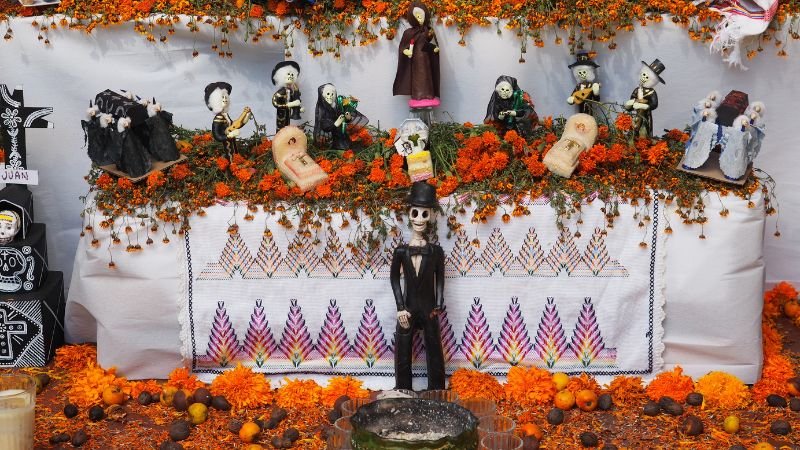
The Day of the Dead Oaxaca Festival is a multi-day celebration that begins on October 31st and continues to November 2nd.
This three-day period allows for various traditions and activities to take place, each with its own significance.
I’ve described these very briefly below.
October 31st: Preparing for the Arrival of Spirits
The Oaxaca Day of the Dead festival commences on October 31st with preparations for the imminent return of departed souls.
Families meticulously clean and decorate the gravesites of their loved ones, creating a welcoming environment for their spirits to reunite with the living.
November 1st: Día de los Angelitos (Day of the Little Angels)
November 1st, All Saints Day in the Catholic Church calendar, is dedicated to the spirits of deceased children.
Families lovingly set up altars and offerings specifically designed to delight the little ones.
November 2nd – Día de los Muertos (Day of the Dead)
The culmination of the festival occurs on November 2nd, when Oaxaca commemorates all departed souls, adults and children alike. In the calendar of the Catholic Church, this is also known as All Souls Day.
Cemeteries become a focal point, transformed into illuminated realms of color and light. Families gather for picnics, music, and heartfelt conversations with their loved ones’ spirits.
If you’re interested in learning more about Oaxaca Day of the Dead, take a look at my in-depth 2023 guide.
PAN DE YEMA: OAXACA DAY OF THE DEAD BREAD
How Do I Get To Oaxaca?
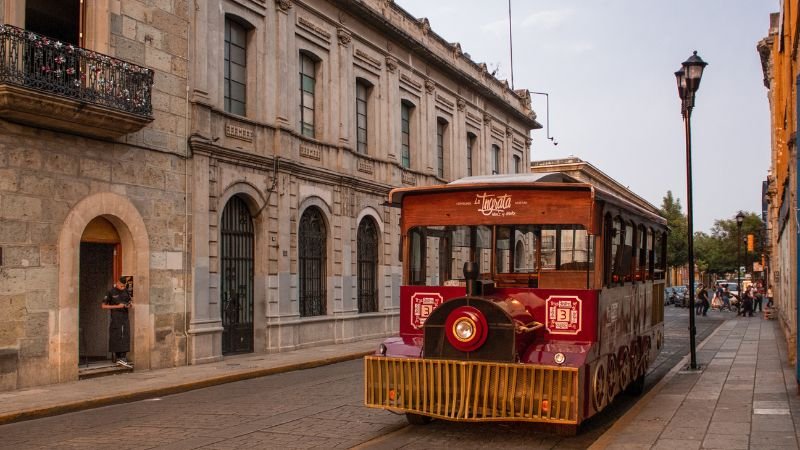
If all the talk about Day of the Dead bread has you thinking about visiting Oaxaca for the Oaxaca Día de los Muertos festival, the next question that you probably have is how do you get there?
Well, while there are some direct flights to Oaxaca out of Dallas and Houston in Texas, the chances are good that you will fly into Mexico City on your way to Oaxaca.
From there, you’ll need to decide how you want to get from Mexico City to Oaxaca.
You might fairly think that you’ll just change flights in Mexico City and fly the rest of the way to Oaxaca (and yes, Oaxaca does have an airport, called Xoxocotlán International Airport). If you’re pressed for time, that’s certainly the best option, and flight time is only one hour and twenty minutes.
However, you’ve actually got three options from which you can choose: plane, car, or bus. It’s too far to walk or cycle, there’s no train, and unless you want to go via Panamá, you can’t go by boat.
By plane, you can fly commercially or (if you can afford it) you can also fly privately. If you travel by car, you can drive yourself or hire a private driver.
If you’re interested in finding out more, check out my article about the best way to get from Mexico City to Oaxaca.
PAN DE YEMA: OAXACA DAY OF THE DEAD BREAD
Where Are The Best Places To Stay In Oaxaca?
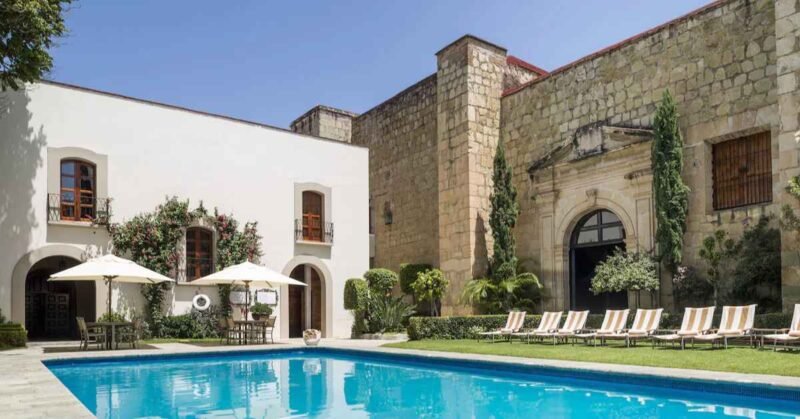
When you make it to Oaxaca, the next obvious question will be where do you stay?
Well, you’re in luck because Oaxaca has an amazing array of places to stay for you to choose from. Whatever your heart desires, you’ll find it in Oaxaca.
You can stay in a luxury hotel, such as the Quinta Real, Casa Santo Origen or the Grand Fiesta Americana.
If a boutique hotel is more your thing, you have great options such as the Palacio Borghese, the Hotel Escondido and Hotel El Callejón.
There are also amazing arty hotels like the NaNa Vida Hotel Boutique or the Pug Seal Oaxaca.
And if you’re travelling with a family, there are great haciendas where you can stay just outside the city. Hacienda Los Laureles Spa is a great example of these.
If you’re looking for great places to stay in Oaxaca, then check out these related articles:
- Best Hotels In Oaxaca
- Best Luxury Hotels In Oaxaca
- Best Boutique Hotels in Oaxaca
- Best Haciendas in Oaxaca
- Best Hostels in Oaxaca
You can also check prices and availability at Booking.com, Tripadvisor or Expedia.
Remember that it pays to be flexible with your travel dates. Check at least a few days on either side of your ideal travel time to secure the best deal, and also consider the shoulder seasons if you can.
And one more final important point: don’t leave it too late to book! Oaxaca Day of the Dead has become extremely popular in the last few years, and the entire city will sell out for those three days months ahead of the festival.
PAN DE YEMA: OAXACA DAY OF THE DEAD BREAD
Final Thoughts
I hope that you have learned something that you didn’t know about Day of the Dead bread.
Although it may not look like much the first time you see it, pan de yema (particularly during the Day of the Dead when it becomes pan de muerto) really is one of Oaxaca’s unique culinary aspects.
It manages to be both a common breakfast staple yet at the same time to be an important part of key Oaxacan tradition.
If you’re visiting Oaxaca, make sure you take the time to stop and try it!

![Oaxaca To Mexico City: 7 Best Ways to Travel [2024]](https://capricioustravel.com/wp-content/uploads/2023/09/How-to-get-from-Oaxaca-to-Mexico-City-800x419.webp)
![Casona Sforza Puerto Escondido: The Definitive Review [2024]](https://capricioustravel.com/wp-content/uploads/2023/10/Casona-Sforza-Pool-and-Pool-Loungers-800x450.webp)
![Hotel Victoria Oaxaca: The Definitive Review [2024]](https://capricioustravel.com/wp-content/uploads/2023/11/Victoria-Hotel-Oaxaca-Poolside-1-800x450.webp)
![Casa Bichu Hotel Boutique: The Definitive Review [2024]](https://capricioustravel.com/wp-content/uploads/2023/10/Casa-Bichu-Boutique-Hotel-Definitive-Review-1-800x450.webp)
![Puerto Escondido To Huatulco: 7 Best Ways To Travel [2024]](https://capricioustravel.com/wp-content/uploads/2023/10/How-to-Get-From-Puerto-Escondido-to-Huatulco-800x450.webp)
![Morelia to Guadalajara: 7 Best Ways to Travel [2024]](https://capricioustravel.com/wp-content/uploads/2024/02/Morelia-to-Guadalajara-Morelia-Cathedral-and-the-Guadalajara-Cathedral.webp)